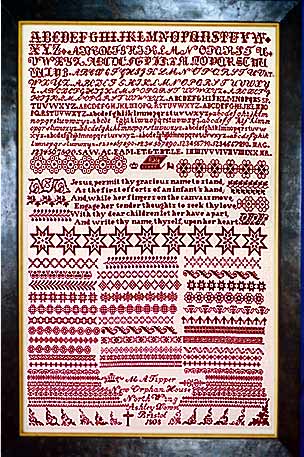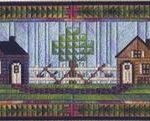Description
M.A. Tipper 1868
The Scarlet Letter
A Bristol Orphan House Sampler from the collection of the Fitzwilliam Museum in Cambridge, England
One of the many important tasks required of domestic servants in the nineteenth century was the skill of marking and repairing household textiles. This practical skill was taught at many of the new schools for poor children in England. One of the largest and most distinctive groups of fine marking samplers of this type was taught at the Bristol Orphanages, founded in 1836 by George Muller, a German minister. Usually worked on a very fine linen with black or red cotton thread, these samplers consist of many lines and styles of alphabets, followed by as many as eighty half or third rows of border patterns. Often a crucifix, a bible, and/or a moral verse was stitched on the sampler, and many times the student would record her address as well, as in Ms. Tipper’s example. Rarely an inch of linen was left bare. It is speculated that more than one child worked on a particular sampler. They often display groups of initials (likely those of fellow students), or groups of numerals, which were used instead of names to identify the pupils.
In the book Samplers by Sir Leigh Ashton (The Medicis Society, London, 1926), he relates an interesting story told by a woman who actually attended one of the Muller (Bristol) Orphanages:
‘Some years ago a lady in Derby acquired one of these samplers from a woman who had been brought up in those homes. The woman gave the information that all the girls there worked these samplers, but were not instructed, learning the patterns from each other.’
This example illustrates nineteen different styles of alphabets (some have initials recorded after them – AT, SP, possibly bearing up the theory that more than one student contributed work to each sampler); three different numeric tests, plus Roman numerals 1 through 10, a verse, and sixty-nine different border patterns!
The sampler requires only cross and four-sided stitches. To most closely approximate the size of the original sampler (11-1/2″x14-3/4″) it would have to be stitched on a linen thread count of between 70 and 75 threads per inch, worked over two threads of linen. As this is unavailable now and unrealistic, the alternatives we offer are to work it on 35-count linen over one thread or on 45 count linen over two threads. We have worked our model on 45 count linen



